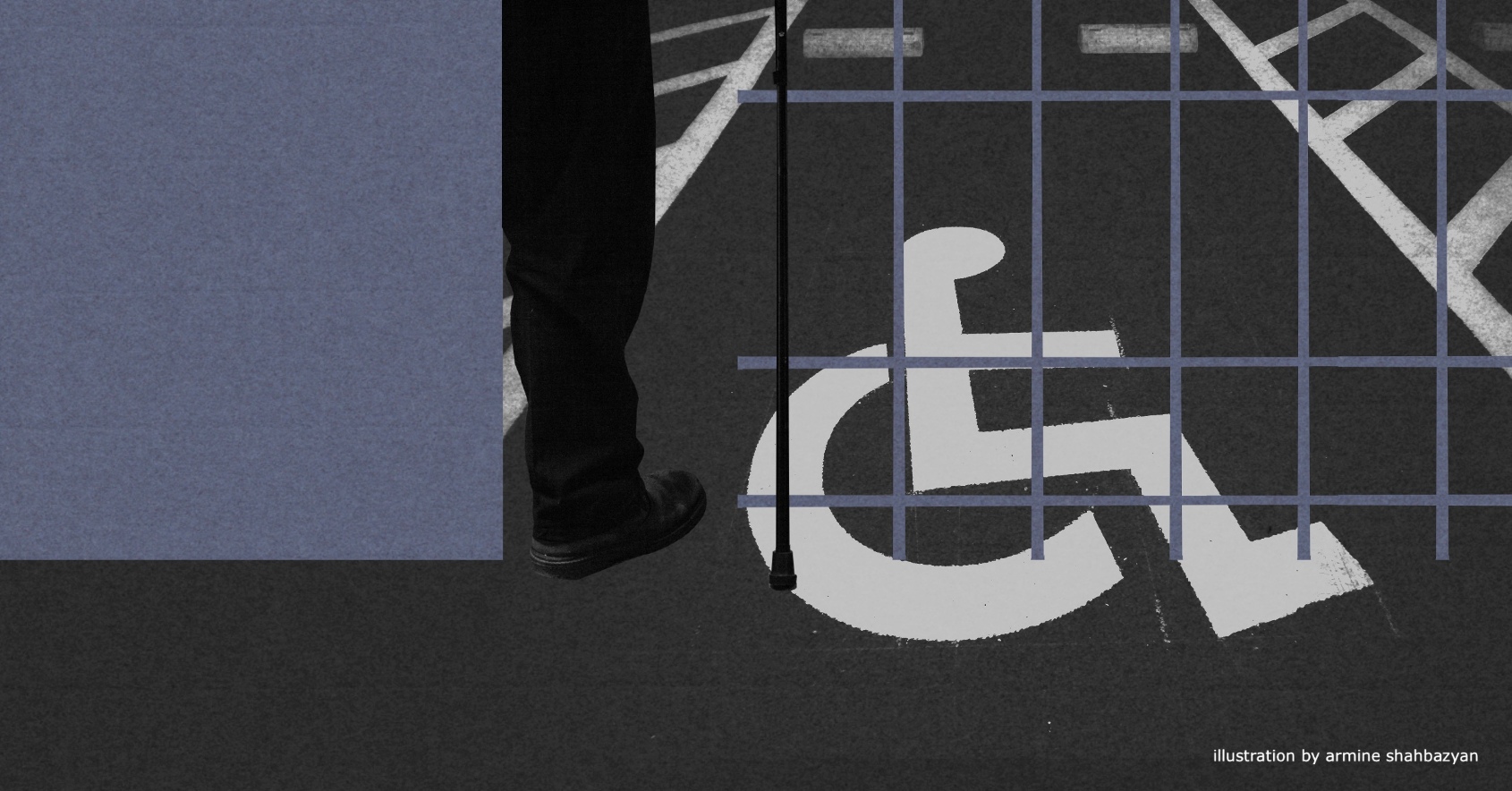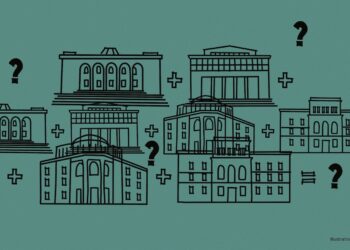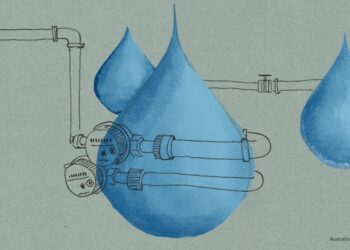
Listen to the article.
“When one of the inmates was released, he gave me this as a gift,” says 50-year-old Ashot, gesturing toward the walking cane resting beside him. Ashot is serving a life sentence and recently received a prescription for a new cane from the prison doctor. After suffering a stroke five years ago, he was confined to a wheelchair, but has since regained limited mobility.
“My left side is weak from the stroke; I can’t even hold a glass with my left hand. The fifth and sixth vertebrae in my neck are misaligned, I have calcium deposits, and I suffer from severe hypertension. My blood pressure can shoot up to 250 in ten seconds and drop to 120 a second later. I could have another stroke at any moment,” he says.
Ashot, who has a severe disability, is held at the Nubarashen Penitentiary. For the last five years since his stroke, he has spent much of his time in the Prisoner’s Hospital: “When I feel better, they discharge me. But after spending 16 years in maximum security, going back there triggers my neurosis.”
He says it’s impossible to stay healthy in a prison cell—there’s almost no sunlight and no fresh air, and you can only take four or five steps inside. The conditions at the hospital are far better: you can walk 15–20 meters in the yard, sit under the trees, and talk to a psychologist or social worker every day. “If you want to talk, you go and spend ten minutes with them. If there’s no social interaction, you’ll go insane.”
“Is this building convenient for people with wheelchairs?”
“The first floor, yes. When you leave the first floor…”
“What about the yard?”
“No, here you need someone’s help. If our friends aren’t outside, any staff member helps, of course. It’s never the case that we have to wait for someone to come. Besides, human relations matter—if they took care of me, respected me, I cannot help but respect them.”
Excerpt from a conversation with Ashot
Ashot was granted a disability status in the summer of 2024 and receives a monthly pension of 37,000 drams ($95): “It’s obviously not much, but since I don’t smoke, I think it will be enough. When I had a stroke and was taken to the hospital, the doctor said, ‘If you want to live, you need to quit smoking.’ I chose to live.”
That desire to live resonates throughout the conversation. Ashot is originally from Artsakh and lived there before his imprisonment. “Sometimes I think, maybe God punished me for something, but maybe He also saved me by bringing me here. Maybe there’s a reason.”
He speaks of future plans, of his family, of his sons. His elderly mother has not been able to visit in the past four years. Before that, she traveled every month from Stepanakert to Yerevan to see him. His father passed away 13 years ago. “You could say I was the reason,” Ashot says quietly. “When I was arrested, he had a heart attack. On the day I was sentenced to life, he had a second. A few years later, the third one took him. I didn’t even get to see his grave. That’s the one thing…” His voice trails off, overcome with emotion.
Moving Independently Is a Challenge
As of October 24, 2024, a total of 135 inmates with disabilities are being held in Armenian prisons, according to data from the Ministry of Justice. Of these, 108 individuals have moderate functional limitations 26 are considered to have severe disabilities, and one is categorized as having profound limitations.
Point 31 of the Government’s 2019–2023 Strategy and Action Plan for the Penitentiary and Probation Sectors, specific measures were mandated to ensure adequate and accessible detention conditions for incarcerated individuals with disabilities.
According to the Ministry of Justice, between 2022 and 2023, approximately 36.4 million AMD worth of construction work was carried out in the Vardashen, Armavir, Sevan, Artik, and Vanadzor penitentiaries to create more accessible conditions for inmates with mobility impairments. The improvements included ramps and handrails, and special handles in toilets, as well as handles and benches in showers. In the Vanadzor penitentiary, a special elevator was installed to help wheelchair users access the yard.
Despite these efforts, the physical infrastructure of penitentiary buildings remains largely inaccessible to people with mobility issues. Laura Gasparyan, head of the Department for the Prevention of Torture and Ill-Treatment at the Human Rights Defender’s Office, noted that while some accessibility features do exist, they are limited and often apply only to specific areas of a facility rather than to entire buildings or prison grounds. For instance, a bathroom may have support bars, but the path to the exercise yard may remain inaccessible.
“Armavir Penitentiary is an exception as it is a single-story building. However, other criteria—such as the width of doors, the dimensions of ramps—are not fully met in any penitentiary,” says Nare Hovhannisyan, President of the Center for Legal Initiatives.
Zaruhi Hovhannisyan, a member of the civilian oversight group monitoring penitentiaries, recalled cases where inmates with disabilities needed their cellmates’ help to use the toilets. The facilities had squat toilets, making their use extremely difficult for these individuals.
“While some ramps and accommodations have been added to different penitentiaries during recent renovations, these improvements are too limited to make the place truly accessible,” Hovhannisyan explains.
Laura Gasparyan also pointed out that the vehicles used to transport inmates are not adapted for people with mobility challenges. According to the annual report by the Human Rights Defender’s Office, these vehicles should have a minimum roof height of 1.6 meters, be equipped with first aid kits and grab bars, and include belts or mechanisms to safely secure a wheelchair—none of which are standard at present.
“The lack of properly equipped vehicles for transporting convicts with mobility impairments could worsen their health conditions, causing difficulties, inconvenience, physical pain, and suffering, which is unacceptable,” the Human Rights Defender’s report states.
Beyond the challenges of independent mobility, these individuals face additional physical and mental suffering. Zaruhi Hovhannisyan pointed out that the absence of necessary accommodations could restrict other rights of convicts with disabilities, such as accessing the library or participating in formal or non-formal educational programs.
Shushan Khnkoyan, the author of the report on the right to education for convicts and member of the public oversight group for penitentiary institutions, said that two individuals were excluded from the alternative graduation exams due to medical reasons. One person could not travel long distances, while the other had mobility limitations. Since the alternative graduation exams are held in only three penitentiaries, convicts must be transferred from other facilities to participate.
Khnkoyan noted that people requiring inclusive education were also left out of the process. Some individuals initially enrolled in the general education program but soon withdrew voluntarily, citing difficulties in following lessons due to intellectual challenges. The lack of a suitable educational program effectively excludes individuals with special educational needs from receiving an education.
Care
At the Prisoner’s Hospital, there is a 68-year-old man named Vachik Pap, small-framed and thin. Serving a five-year sentence for theft, Vachik suffers from heart, lung and kidney problems, along with severe functional mobility. He receives an old-age pension, not disability support. His wife, who has cancer, receives this money and sends a portion to cover his expenses.
Speaking with difficulty and gasping for breath, Vachik repeatedly expresses his gratitude for the Prisoner’s Hospital. “Both the management and convicts respect me a lot,” he says, adding that because of his respiratory problems, he cannot bathe by himself. “When I don’t feel well, my fellow convicts come and help me take a shower.”
Nare Hovhannisyan highlights how inmates often take on caregiving roles for their disabled or seriously ill peers, assisting with basic mobility and daily needs. In one example, a wheelchair-bound prisoner, with the help of fellow inmates, managed to construct a makeshift bench to use while showering.
Despite such displays of solidarity, serious concerns remain about the systemic provision of care within Armenia’s penitentiary institutions. A report by the Human Rights Defender cites the case of a paralyzed, wheelchair-bound individual on a ventilator who required continuous nursing care. After just one week in a specialized hospital, the individual was discharged. Only the intervention of the Human Rights Defender ensured a transfer to a palliative care facility instead of being returned to prison.
“Based on complaints submitted to the Human Rights Defender and findings from monitoring visits, it has been recorded that the level of care provided to prisoners, despite certain improvements, remains inadequate,” the report concludes.
Slow-moving Process
Karen (name changed), a 49-year-old inmate serving a life sentence, suffers from multiple chronic conditions. He has applied to be formally recognized as a person with a disability, but holds little hope for a positive outcome. “That’s just one issue,” he says. “They even revoked the disability status of someone with cancer.” He’s referring to a former cellmate who died a few months ago. “They gave him disability status for a year, then took it away. He waited eight months without receiving a pension or any other support. And then he just died. He had no one—no mother, no father, no brother…”
The process for obtaining disability status and undergoing functionality assessments remains a major source of frustration for incarcerated individuals. The Human Rights Defender’s office and other advocacy groups have received numerous complaints. According to Laura Gasparyan, the most common concern in recent years has been delays in the assessment process.
In 2023, for instance, several prisoners were required to undergo additional medical tests to confirm diagnoses, prompting a 60-day suspension of their functionality assessments. However, those tests were not carried out within the suspension period, leading to the automatic termination of the process once the deadline passed.
The Human Rights Defender’s annual report warns that such delays may constitute a violation of prisoners’ right to social security. Gasparyan noted that after raising these concerns with the authorities, some improvements were observed and the number of complaints decreased.
Other Concerns
While recent years have seen fewer complaints from inmates with vision, hearing, or other sensory impairments, human rights defenders stress that systemic support for these individuals remains absent. There is still no regular access to legal texts in Braille, audiobooks, or assistive tools like white canes. Instead, accommodations are made only in response to individual complaints. For example, Laura Gasparyan noted that after issues were raised regarding the availability of hearing aids and eyeglasses, those concerns were addressed—but only on a case-by-case basis.
In a positive development, the Penitentiary Service and the National Library signed a memorandum in October 2024 to expand access to educational resources for inmates. Under the agreement, the National Library will help establish an electronic library in correctional facilities and provide temporary access to Braille books and audio materials.
Click here for photos.
Law & Society
Behind Bars: Work and Education as a Lifeline
In Armenia’s prisons, work and education offer rare paths to purpose, income and potential early release. Astghik Karapetyan explores how inmates, including those serving life sentences, are learning trades, earning degrees and pushing for systemic change.
Read moreMotherhood Behind Bars
Exploring the lives of incarcerated mothers at Armenia's Abovyan Penitentiary, Astghik Karapetyan delves into the challenges of raising children in confinement, the impact on maternal bonds, and the institutional efforts to balance rehabilitation with the children’s best interests.
Read moreThe Housing Program Helping to Revitalize Armenia’s Border Settlements
Armenia’s state-funded housing program is transforming border settlements, providing thousands of families with new homes while boosting local economies. With strong demand leading to expansion, the initiative is revitalizing rural communities, increasing property values, and encouraging both local and displaced residents to settle and thrive.
Read moreAnatomy of a Process: Yerevan Transportation Reform
Yerevan's ongoing transportation reform, launched in 2017, highlights the lack of strategic planning, leadership and accountability. Without a comprehensive approach, clear oversight and implementation, any reform process will not fulfill its intended goal: to benefit the public.
Read moreReservoirs: Key to Armenia’s Water Security Amid Climate Change
Armenia faces mounting water security challenges as climate change intensifies floods and droughts. Reservoirs can play a pivotal role in managing these risks, ensuring water availability and supporting sustainable development through improved storage, infrastructure, and strategic planning initiatives. Hranoush Dermoyan explains.
Read moreNew Law on Higher Education: Meaningful Reform or Top-Down Policy?
A new Draft Law on Higher Education and Science has ignited public debate in Armenia. While introducing necessary reforms, experts fear certain amendments could threaten the core principles of the higher education system, including academic autonomy, regional equity and free competition.
Read moreAbundance of Both Water and Mismanagement
Armenia faces growing challenges in managing its water resources. Lake Sevan, a crucial water source, is being overused for irrigation, raising concerns about long-term sustainability. Mariam Tashchyan explores the factors behind Armenia’s water crisis.
Read more







